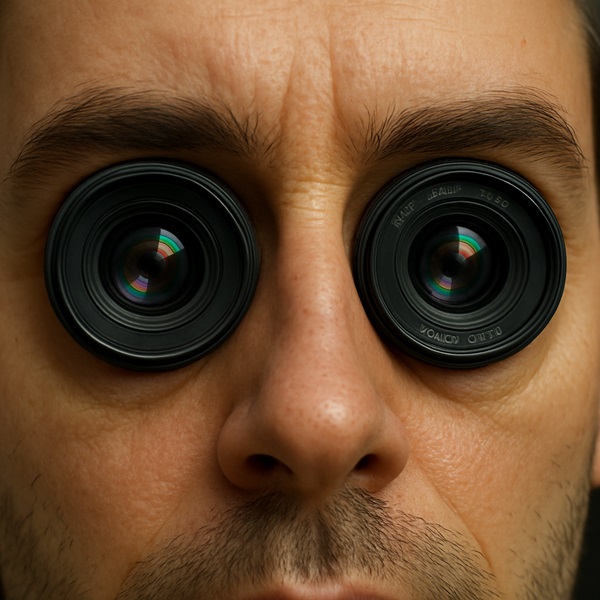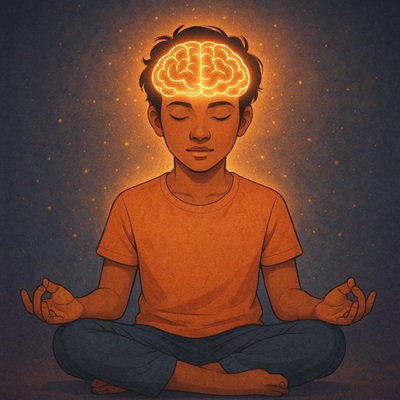Train Your Brain: 6 Powerful Techniques to Develop Photographic Memory
Have you ever dreamed of flipping through a book and memorizing every page? While photographic memory, also known as eidetic memory, is still debated in scientific circles, many people believe in the brain’s extraordinary capacity to retain vivid mental images.

As a kid, I had seen on TV some cartoon characters and robots like “Vicky”, the small wonder, being able to read books with lightning fast speed by just looking at the pages as if they are clicking photos using their eyes as cameras and brains as storage. At that time, I did not know that someday I would stumble upon materials that are actually based on that specific subject.
So, is it possible to develop an eidetic memory?
There have been people who had the natural ability to capture exact pictures of what they are seeing in their minds—people like Kim Peek (who could read two pages at once) could remember places and information like machines. Also, there is Stephen Wiltshire who can draw huge landscapes to exact detail by looking at it just once. But there are two similarities between Kim and Stephen: they both were born with this ability and they both were autistic savants, which means that they were individuals with autistic spectrum disorder with exceptional abilities.
Although there have been many people who had eidetic memory due to their special brain structures which also resulted in disorders like autism, there also have been people who were gifted with such abilities by birth.
However, not all of us are born with a photographic memory. Many memory experts agree: you can train photographic memory with the right techniques. Just like singing or painting, memory skills can be developed through practice.
In this post, I’ll share 6 easy but powerful eidetic memory training exercises to help you enhance your mental clarity and potentially develop photographic memory with consistent effort.
Before that, I want to clarify that there is a slight difference between eidetic memory and photographic memory. The first refers to the ability to store all types of sensory information, whereas the latter is only about the memory involving visuals. But I will use these both terms interchangeably in this post.
? Is Photographic Memory Real?
Some historical figures like Nikola Tesla and Leonardo da Vinci were believed to have photographic memory. However, modern science hasn’t fully validated it as a measurable cognitive ability.
That said, don’t let skepticism stop you. Just like not everyone becomes a concert pianist, not everyone may achieve perfect photographic recall—but anyone can improve memory with the right training.
Also photographic memory is more about being able to bring information from the subconscious mind to our conscious mind. Our subconscious mind, being so powerful, can store information to accurate detail. However, our conscious mind has limited ability to process and store vast information that is not relevant to what we are doing in a moment.
? 6 Practical Exercises to Train Photographic Memory
1. ? Visualize Familiar Places

Choose a specific place for this exercise—such as your room, office, gym, or grocery store—and try to recall every minute detail of that location. However, avoid putting too much pressure on your mind.
To help with this process, you can use a notepad to jot down everything you remember. If you’re more visually inclined, you might even prefer sketching or painting the scene to capture the details.
Once you’ve visualized the place as thoroughly as you can, go there and observe it closely. Then, return and repeat the visualization process, this time adding any new details you noticed.
With consistent practice, you’ll notice a remarkable improvement in your mind’s ability to remember places vividly. Repeat this regularly to train photographic memory and sharpen your visual recall.
This exercise taps into your subconscious and strengthens eidetic visualization skills over time.
2. ? Practice Being Fully Present
Try to be more present in each moment. When you focus your attention on the here and now, your mind functions more efficiently because it’s not distracted by unnecessary or intrusive thoughts. Being fully present also heightens your awareness of the information your five senses are constantly receiving.
Bringing your focus to the present moment allows you to consciously register what’s happening, which makes it much easier to recall details later. This practice is known as mindfulness meditation, and the techniques involved in mindfulness meditation are known to strengthen sensory perception and cognitive functions by training the mind to stay fully engaged in the task at hand.
Mindfulness is a powerful gateway to mastering how to train for photographic memory.
3. ? Relive Memories with Friends
Sharing a memory with someone else gives you a valuable opportunity to actively engage in recalling past events as vividly as possible.
I personally love doing this—but the key is to treat it like a playful activity. I try to recall events in rich detail and then surprise others with the astonishing specifics I remember. It’s a fun way to exercise my memory, and it also increases the likelihood of bringing information from the subconscious mind into conscious awareness.
If you stay a bit more mindful while discussing a past event, you’ll notice your mind beginning to flash old images. Try to pay close attention to these mental visuals—they can significantly enhance your ability to recall experiences clearly and deeply.
4. ? Use the Memory Peg Technique

Turn boring memory tasks into something fun! The memory peg technique is a clever trick that turns memorization into an enjoyable task for your brain.
This method taps into your creativity by associating the item you want to remember with an interesting or vivid image.
For example, imagine you need to buy several items but don’t want to make a list. You can use this technique by creating memorable mental pictures for each item. Say one of the items is a “pen.” You might imagine a rocket-shaped pen being operated by scientists, ready to launch into space! Trust me—when you link things this way, it becomes nearly impossible to forget them.
This technique not only helps you remember things better but also exercises your imagination and strengthens your ability to visualize. Creative visualization is a powerful practice for improving memory and is also one of the most effective ways to communicate with your subconscious mind. You can learn more about how to tap into this inner power by exploring these 7 habits that help you access your subconscious mind.
5. ? The Military Flash Technique (Snapshot Memory Training)
The Military Flash Technique is a classic memory training method used to develop quick and accurate visual recall—almost like taking a mental photograph. Originally used in military training to improve rapid information retention, this method helps sharpen focus and strengthens the brain’s ability to capture and store visual information instantly.
This technique is especially useful for anyone seeking to improve eidetic memory, visual learning, or overall mental sharpness.
How to Practice the Military Flash Technique:
- Set up your environment:
- Choose a dark room where you have easy access to a light switch.
- Hold a piece of paper in front of you with something written or drawn on it—this could be a word, number, short paragraph, or even an image.
- Perform the exercise:
- Turn the light on briefly to view the paper, then immediately switch it off.
- When the room goes dark, focus on the mental image that briefly flashes in your mind.
- Try to observe as much detail as possible in that fleeting moment—letters, shapes, positions, or any distinct features.
- Refine your recall:
- After a few rounds, try to mentally reconstruct the image or text without turning the light back on.
- Challenge yourself to remember not only the content but also the structure and spacing.
- Repeat and train regularly:
- Repeat this process with different materials and increase the complexity over time.
- With consistent practice, your brain will adapt to capturing and storing visual data more effectively, leading to faster recall and sharper concentration.
This technique exercises both your visual memory and concentration, and over time, it can significantly boost your ability to absorb and recall information under pressure—just like it’s designed to do in military training scenarios.
6. ?♂️ Relax Your Mind with Meditation

Remember, when we talk about memory, we’re actually referring to a function of the subconscious mind. The act of recalling information is the process of transferring data from the subconscious to the conscious mind.
To improve our ability to recall, it’s essential to relax the conscious mind. When the mind is calm and free from distractions, it becomes much easier to access and retrieve stored memories.
One of the most effective ways to achieve this state of relaxation is through meditation. It not only quiets the conscious mind but also enhances awareness and mental clarity. If you’re new to the practice, here’s a helpful guide on what meditation is and how to do it in simple terms.
In addition to meditation, you might also benefit from practicing mindfulness exercises. These techniques help you stay present and focused, creating the right mental space for memory to emerge naturally. For a great starting point, check out these simple mindfulness exercises for beginners.
? Looking for a Complete Memory Training Program?
If you’re serious about learning how to get eidetic memory, I recommend trying Zox Pro. It’s a highly rated memory training system that focuses on image streaming, visualization, and photographic memory techniques to expand your brain’s recall power.
?♀️ Frequently Asked Questions (FAQ)
? Is it possible to develop eidetic memory?
While not scientifically proven for everyone, many people have improved their visual recall through eidetic memory training techniques.
❓ How to develop photographic memory naturally?
Use visualization, mindfulness, and creative memory methods like the peg technique. These help your brain store and retrieve images with more accuracy.
? How to train yourself to have photographic memory?
Start with simple daily exercises like visualizing places, using memory pegs, and practicing the military flash method. Over time, you’ll notice improvement.
? Can you actually train photographic memory?
Yes, with consistent practice. Your brain is like a muscle—the more you work it, the stronger your photographic recall becomes.
?Can you have photographic memory without autism?
Yes, it is absolutely possible to have a photographic memory without being on the autism spectrum. While some individuals with autism may exhibit extraordinary memory skills, having an eidetic or photographic memory is not exclusive to them. Anyone can explore eidetic memory training and learn how to develop photographic memory with consistent practice and the right techniques.
?What is the difference between eidetic memory and photographic memory?
Though often used interchangeably, there is a subtle difference:
- Eidetic memory refers to the ability to recall images, sounds, smells, and even feelings with great precision—essentially involving multiple senses.
- Photographic memory, on the other hand, is more specific to visual memory, often associated with recalling numbers, text, and detailed images as if they were “photographs” in the mind.
So, when learning how to train for photographic memory, the focus is primarily on visual recall, whereas eidetic memory involves a broader sensory experience.
✅ Final Thoughts + CTA
Whether you believe in true photographic memory or not, one thing’s for sure: your brain is capable of incredible things.
With the exercises above and a little daily effort, you’ll start to train photographic memory, sharpen your focus, and improve your ability to recall visuals in stunning detail.
? Ready to take your memory to the next level?
? Explore Zox Pro and unlock your brain’s true potential today.
I hope you enjoyed reading this post! I’d really love to hear your thoughts, so feel free to share your comments in the box below. If you have anything to add, your input is more than welcome.
You can also reach out to me directly through the contact page—I’m always happy to help with any questions or concerns you may have.
And if you found this post helpful, please consider sharing it with your friends or on your social media. It means a lot and helps spread the message further!

